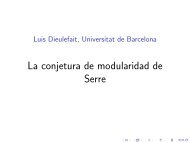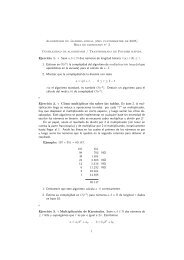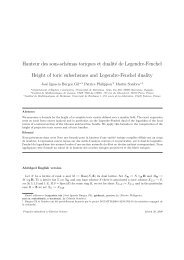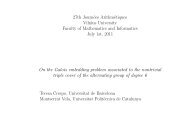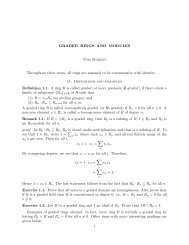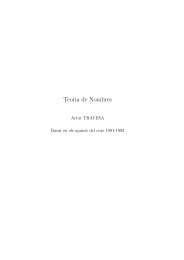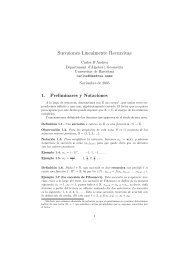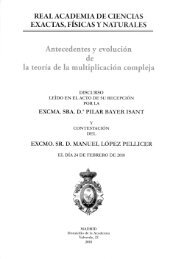CORBES DE SHIMURA I APLICACIONS - Universitat de Barcelona
CORBES DE SHIMURA I APLICACIONS - Universitat de Barcelona
CORBES DE SHIMURA I APLICACIONS - Universitat de Barcelona
Create successful ePaper yourself
Turn your PDF publications into a flip-book with our unique Google optimized e-Paper software.
1.1. Definicions i exemples 5<br />
Per <strong>de</strong>signar aquesta àlgebra es fa servir la notació<br />
H = (a, b)K,<br />
tot i que no és in<strong>de</strong>pen<strong>de</strong>nt <strong>de</strong> la base:<br />
base {1, j, i, k} ⇒ H = (b, a)K,<br />
base {1, i, k, j} ⇒ H = (a, −ab)K,<br />
base {1, j, k, i} ⇒ H = (b, −ab)K,<br />
base {1, ci, j, k} ⇒ H = (ac 2 , b)K.<br />
1.1.9 Observació. Si el cos fós <strong>de</strong> característica 2, es tindria una<br />
base {1, i, j, ij}, amb i 2 + i = a, j 2 = b, ij = j(1 + i). Però aquest<br />
cas no el tractarem.<br />
Tot seguit comprovem que, efectivament, H = (a, b)K és una<br />
K−àlgebra central i simple, fent servir l’operador <strong>de</strong> Lie<br />
[x, y] = xy − yx.<br />
• H = (a, b)K és central: si x = x0 + x1 i + x2 j + x3 k ∈ Z(H),<br />
aleshores<br />
0 = [i, x] = 2ax3 j +2x2 k,<br />
0 = [j, x] = −2 bx3 i −2 x1 k.<br />
Atès que 1, i, j, k són una K−base <strong>de</strong> H, es <strong>de</strong>dueix x1 = x2 =<br />
x3 = 0. Aleshores, x = x0 ∈ K.<br />
• H = (a, b)K és simple: sigui J = 0 un i<strong>de</strong>al bilàter i x ∈ J −{0}.<br />
Si x = x0 ∈ K ∗ , llavors x ∈ H ∗ i J = H. Si x = x0, alguna<br />
altra coor<strong>de</strong>nada serà = 0. Atès que<br />
[j,[i, x]] = −4 bx2 i ∈ J,<br />
[k,[j, x]] = 4abx3 j ∈ J,<br />
[i,[k, x]] = −4 a x1 k ∈ J,<br />
J conté algun element invertible i, per tant, J = H.



